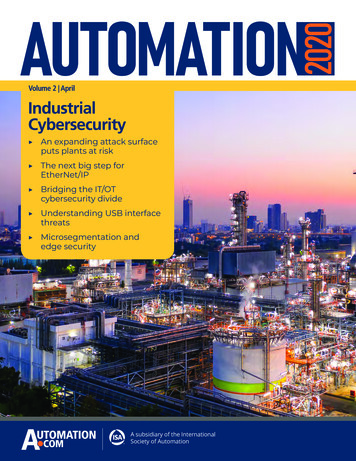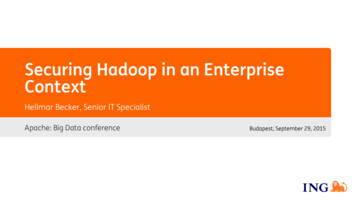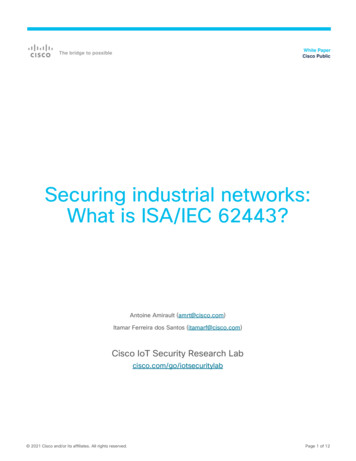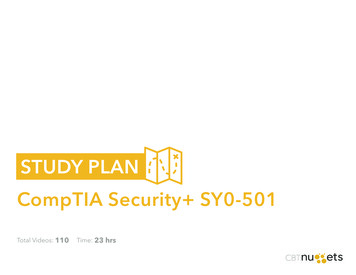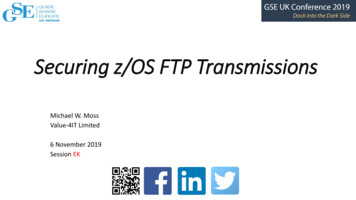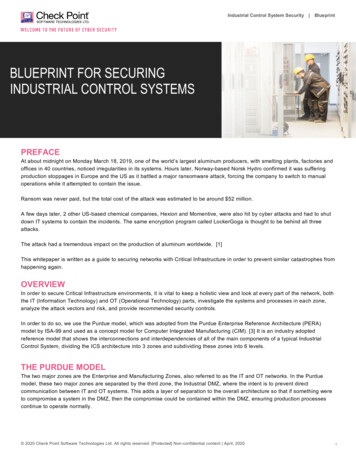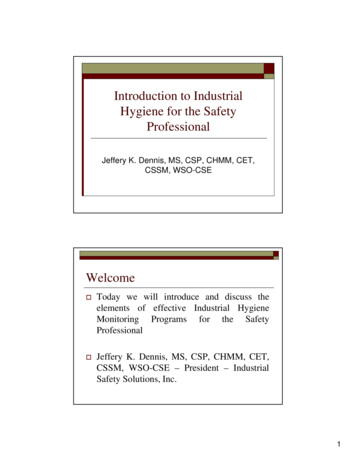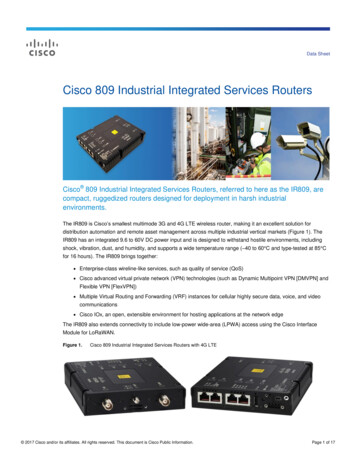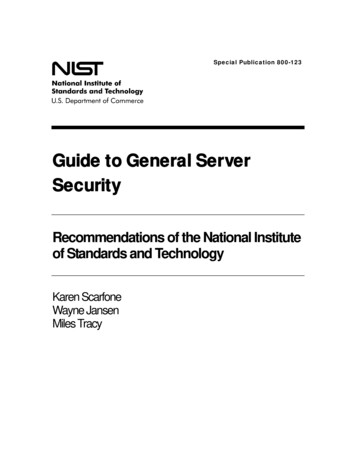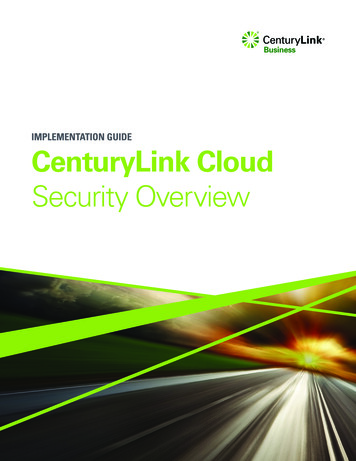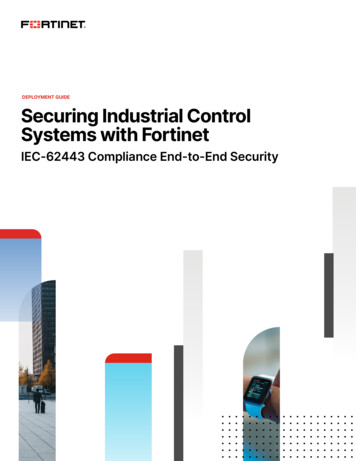
Transcription
DEPLOYMENT GUIDESecuring Industrial ControlSystems with FortinetIEC-62443 Compliance End-to-End Security
Table of ContentExecutive Summary . . . . . . . . . . . . . . . . . . . . . . . . . . . . . . . . . . . . . . . . . 3Potential Vulnerabilities . . . . . . . . . . . . . . . . . . . . . . . . . . . . . . . . . . . . . . 3Addressing The Problem . . . . . . . . . . . . . . . . . . . . . . . . . . . . . . . . . . . . . 4Securing ICS/SCADA with Fortinet . . . . . . . . . . . . . . . . . . . . . . . . . . . . . 4Comprehensive Multi-Layered Security . . . . . . . . . . . . . . . . . . . . . . . . 5Taking ICS Security to the Next Level with Fortinet andNozomi Networks Joint Solution . . . . . . . . . . . . . . . . . . . . . . . . . . . . . . 6Centralized Management, Logging, and Reporting . . . . . . . . . . . . . . . 7Specific ICS/SCADA-AWARE Functionality . . . . . . . . . . . . . . . . . . . . . . 7Zone Access Control with FortiAuthenticator and FortiToken . . . . . . . 7Securing the Historian with FortiDB . . . . . . . . . . . . . . . . . . . . . . . . . . . . 8Provide Secure Ethernet Access with FortiSwitchand FortiSwitchrugged . . . . . . . . . . . . . . . . . . . . . . . . . . . . . . . . . . . . . . 8Securing the Web-based HMI with FortiWeb . . . . . . . . . . . . . . . . . . . . 8Securing the #1 Attack Vector with FortiMail . . . . . . . . . . . . . . . . . . . . 8Responding to Advanced Persistent Threats . . . . . . . . . . . . . . . . . . . . 8Government and Accreditation and Assurance . . . . . . . . . . . . . . . . . . 9Summary . . . . . . . . . . . . . . . . . . . . . . . . . . . . . . . . . . . . . . . . . . . . . . . . . 92
DEPLOYMENT GUIDE Securing Industrial Control Systems with FortinetExecutive SummaryIn recent years, the Industrial Control Systems (ICS) upon which much of our critical infrastructure and manufacturing industrydepends, have come under increasingly frequent and sophisticated cyber-attacks.In part, this is a consequence of the inevitable convergence of Operational Technology (OT) with Information Technology (IT).As in all spheres of computing, the advantages of increased network connectivity through open standards such as Ethernet andTCP/IP, as well as the cost savings derived from replacing dedicated proprietary equipment with off-the-shelf hardware andsoftware, come at the cost of increased vulnerability.However, while the impact of a security breach on most IT systems is limited to financial loss, attacks on ICS have the addedpotential to destroy equipment, threaten national security, and even endanger human life.With this critical distinction also comes a troubling difference in the profiles and motivations of potential attackers. While thelion’s share of modern cybercrime is motivated by financial reward, ICS have recently become attractive targets for terrorism andcyber-warfare.As a consequence, the financial and human resources available to its perpetrators can be an order of magnitude greater thanthose of conventional cybercriminals. This is especially true of highly targeted state-sponsored attacks, of which STUXNET (firstappearing back in 2010) is considered one of the most sophisticated examples so far.The purpose of this solution guide is to show how, in spite of these and many other challenges, Fortinet’s Solutions can help toensure the safety and reliability of ICS, and in particular those employing Supervisory Control and Data Acquisition (SCADA).Potential VulnerabilitiesDue to their unique history and conception, separate from the evolving world of IT, ICS present a number of unique challenges:nnInherentlack of security: Much of the technology underpinning ICS, while extremely robust and reliable, was neverdesigned to be accessible from remote networks, and so security relied instead upon restricted physical access, andthe relative obscurity of its components (e.g., RTUs, PLCs, etc.) and their (mostly serial) communications protocols (e.g.,Modbus, RP-570, PROFIBUS, Conitel, etc.).nnThe“air-gap” fallacy: The superficially seductive idea of creating an “air-gap” between the ICS and all other networksis no longer realistic for the vast majority of real-life applications. As more and more of today’s ICS components relyon software updates and periodic patching, it is now virtually impossible to avoid at least occasional data transfer intothe ICS. Even in the absence of permanent network connections (or those employing only unidirectional devices suchas optical data diodes), “air-gapped” networks are still vulnerable to the connection of infected PCs or storage devicessuch as USB drives (one of the infection vectors of STUXNET).nnExpandingattack surface: As proprietary, dedicated solutions are replaced with off-the-shelf hardware and software,employing open standards such as Ethernet, TCP/IP, and Wi-Fi, the number of potential vulnerabilities increasesexponentially. The recent proliferation of mobile devices together with trends such as BYOD only exacerbate theproblem further.nnContinueduse of outdated hardware and software operating systems (sometimes pre-dating even the very notion ofcybersecurity) which may be incompatible with standard modern defenses such as antivirus software.nnInfrequentupdates and patching due to the complexity, cost, and potential service disruption entailed. It is not alwayspractical, for example, to interrupt a plant’s operations whenever one of its operational servers needs patching.nnLargenumbers of simple, unsecured telemetry devices such as sensors and pressure gauges, whose data, ifmanipulated, could nevertheless carry huge consequences for the safety and reliability of the overall system.3
DEPLOYMENT GUIDE Securing Industrial Control Systems with FortinetnnUseof embedded software written with scant adherence to the security techniques and best practices of modern coding.nnInsufficientregulation of component manufacture and supply chain, introducing the possibility of equipmentcompromise, even prior to installation.nnLimitedaccess control / permission management: As previously isolated or closed systems have been interconnected,the controls imposed on exactly who can access what, have not always kept pace with IT security best practices.nnPoornetwork segmentation: The standard security practice of partitioning networks into functional segments which,while still interconnected, nevertheless limit the data and applications that can overlap from one segment to another, isstill underutilized within ICS as a whole.nnLackof security expertise among the engineers who have traditionally designed and maintained the systems.Addressing the ProblemThe good news is that in recent years, the inherent problems and vulnerabilities of ICS have become more widely recognized,and the first steps have now been taken to rectify them.One way this is occurring is through the help of government bodies such as the The Industrial Control Systems CyberEmergency Response Team (ICS-CERT) in the US, and the Centre for Protection of National Infrastructure (CPNI) in the UK, bothof which publish advice and guidance on security best practices for ICS.Another way is through the definition of common standards such as ISA/IEC-62443 (formerly ISA-99). Created by theInternational Society for Automation (ISA) as ISA-99 and later renumbered 62443 to align with the corresponding InternationalElectro-Technical Commission (IEC) standards, these documents outline a comprehensive framework for the design, planning,integration, and management of secure ICS.Although still a work in progress, the standard provides practical guidance, such as the model of “zones, conduits, boundaries,and security levels,” and addresses the most pressing deficiencies of ICS network security.Implementation of the zones and conduits model, which is recommended by both ICS-CERT and CPNI, greatly reduces the riskof intrusion, as well as the potential impact should such a breach occur.The basic strategy outlined in the standard, is to segment the network into a number of functional “zones” (which may alsoinclude subzones), and then to clearly define the “conduits” as all essential data and applications allowed to cross from onezone to another. Each zone is then assigned a security level from 0 to 5, with 0 representing the highest level of security and 5the lowest. Strict access controls can then be imposed limiting access to each zone and conduit based on the authenticatedidentity of the user or device.This is a strategy that maps extremely well to the range of capabilities delivered by Fortinet’s Firewall Solution, and in particularthe Internal Segmentation Firewall (ISFW).Securing ICS/SCADA with FortinetAs with any effective security implementation, the first step is to fully assess the business and operational risks and to define anappropriate strategy commensurate with those risks. A major part of this will include defining the zones, conduits, boundaries,and security levels outlined in IEC-62443.This will typically look something like the network represented in Figure 1.4
DEPLOYMENT GUIDE Securing Industrial Control Systems with FortinetFigure 1: Security levels as depicted in the ISA 99 Standard.Comprehensive Multi-layered SecurityWith its multi-layered defense, high-availability design, and optional rugged form-factor, the FortiGate range of securityappliances is the perfect choice for implementing the zones and conduits model, no matter how critical the ICS infrastructure, orhow harsh the environment.5
DEPLOYMENT GUIDE Securing Industrial Control Systems with FortinetUsing the Internal Segmentation Firewall (ISFW) deployment mode, which combines functional and physical segmentation, theFortiGate combines high-performance, next-generation firewall (NGFW) functionality and robust two-factor authentication,with antivirus, intrusion prevention, URL filtering, and application control. With a wide selection of high-speed LAN interfacesand the hardware acceleration derived from its custom ASIC design, the FortiGate has been proven to deliver inter-zoneperformance in excess of 100 Gbps. Using the granular security policies available with FortiGate’s ISFW deployment mode, ICSzones and conduits can be enforced based on criteria such as user identity, application, location, and device type. In this way,the FortiGate can effectively lock down each zone, ensuring that only legitimate, prescribed traffic, originating from authorizedendpoints can pass from one zone to another. The embedded security of these highly flexible and scalable products comesfrom a combination of their operating system, FortiOS, the FortiAuthenticator and FortiToken authentication solutions, and theautomated, 24/7, self-learning, continuous threat response resources of FortiGuard. However, for a thorough analysis of ICSnetworks, their processes and protocols, a more proactive approach is required.Taking the ICS Security to the Next Level with Fortinet and Nozomi Networks Joint SolutionFortinet and Nozomi Networks are collaborating to provide ICS environments with a comprehensive security solution. Thesolution combines Nozomi Networks’ SCADAguardian and its deep understanding of ICS networks, protocols, and devicebehavior with Fortinet’s extensive network security expertise through its FortiGate. SCADAguardian’s non-intrusive ICS protocolmonitoring capabilities profile the behavior of industrial devices and detect anomalies and critical states in the ICS network. Itworks closely with FortiGate to respond and provide a secure gateway between the OT and IT networks as shown in Figure 2.Designed to minimize system downtime and limit data loss, the Fortinet-Nozomi Networks solution optimizes productivity andbusiness continuity in industries reliant on ICS networks.How do we do this? By placing a Nozomi Networks SCADAguardian appliance in the OT network, it will passively monitor thenetwork traffic creating an internal representation of the entire network, its nodes, and the state and behavior of each device inthe network. By doing so, the solution provides advanced visibility, monitoring, alerting, reporting, troubleshooting, and forensiccapabilities. If an anomaly or suspicious behavior is detected, an alarm is generated and sent to security operators and networkadministrators. At the same time, SCADAguardian is capable of automatically modifying the right policy in FortiGate to block thesuspicious traffic. The proactive Fortinet-Nozomi Networks solution provides sophisticated detection of ICS security issues withproactive threat remediation and containment within an industrial environment.Figure 2: Safe gateway between the OT and IT networks.6
DEPLOYMENT GUIDE Securing Industrial Control Systems with FortinetCentralized Management, Logging, and ReportingManagement of the infrastructure, which is consolidated through the FortiGate, is accomplished via FortiManager andFortiAnalyzer, combining centralized configuration with reporting, visibility, event logging, and analysis, to create acomprehensive, real-time network monitoring and control center.Specific ICS/SCADA-AWARE FunctionalityUsing predefined and continually updated signatures, the FortiGate can identify and police most of the common ICS / SCADAprotocols (see list below) for the purpose of defining 04nnDNP3nnModbus/TCPnnEtherCATnnOPCnnPROFINETThis is done through the configuration of security policies in which multiple services, such as IPS, antivirus, and applicationcontrol can be mapped to each protocol.In parallel to this specific protocol support, additional vulnerability protection is provided for applications and devices from themajor ICS manufacturers (see list below) through a complementary set of his provides a more granular application-level control of the traffic between zones and enables the FortiGate to detectattempted exploits of known vulnerabilities relating to any of the supported vendors’ solutions.With the deployment of the integrated Fortinet-Nozomi solution, the following additional protocols are EtherNet/IPnnCEI79-5/2-3Moreover, the solution is able to learn the behavior of all other protocols as well as define custom ones.Zone Access Control with FortiAuthenticator and FortiTokenApplying granular control of the access to each zone and conduit based on both user and device is therole of FortiAuthenticator’s integration with FortiGate and directory services. FortiAuthenticator useridentity management appliances provide two-factor authentication, RADIUS, LDAP, and 802.1X wirelessauthentication, certificate management, and single sign-on. FortiAuthenticator is compatible with andcomplements the FortiToken range of two-factor authentication tokens for secure access, enablingauthentication with multiple FortiGate network security appliances and third-party devices. Together,FortiAuthenticator and FortiToken deliver scalable, cost-effective, secure authentication within the entirenetwork infrastructure.7
DEPLOYMENT GUIDE Securing Industrial Control Systems with FortinetSecuring the Historian with FortiDBAll central databases present an attractive target for cyber-attacks, but those underpinning ICS areespecially vulnerable since, due to their history, security was not inherent in their deployment and scripting.To help assess the current security level, address any vulnerabilities, and monitor all subsequent access forsuspicious activity, FortiDB provides a flexible policy framework to secure these critical resources.Provide Secure Ethernet Access with FortiSwitch and FortiSwitchruggedThe need for secure Ethernet access may exceed the number of ports available in the chosen modelof FortiGate. In this case the FortiSwitch or FortiSwitchRugged can augment your existing ports andintegrate seamlessly into your FortiGate environment via FortiLink. With FortiLink the FortiSwitch orFortiSwitchRugged are auto discovered by the FortiGate and can quickly and easily be provisioned with thesame security polices as the ports hardwired in the FortiGate.There are various port density, speed, and uplink configurations available and they can be stacked withoutregard to model or series. These switches can also support Mlag for non blocking dual link supportsometimes key for redundancy in SCADA environments.Securing the Web-based HMI with FortiWebWhile the cost and usability benefits of controlling ICS through a web-based console are self-evident,the impact of intrusion to the back end is clearly much greater within this environment than for mostother web servers.Using advanced techniques to provide bidirectional protection against malicious sources, application layerDoS Attacks, and sophisticated threats like SQL injection and cross-site scripting, FortiWeb adds anothercrucial layer to your ICS defenses.Securing the #1 Attack Vector with FortiMailAlthough not specific to ICS or its components, unsecured email – especially when combined with socialengineering—remains the #1 attack vector for the majority of known threats.Protecting against inbound attacks, including advanced malware, as well as outbound threats and data loss,FortiMail provides a single solution combining anti-spam, anti-phishing, anti-malware, sandboxing, data lossprevention (DLP), identity-based encryption (IBE), and message archiving.Responding to Advanced Persistent ThreatsMost of the discussion so far has focused on the detection and blocking of attacks through the use of signatures, yet thisapproach relies on having encountered some close variant of the threat before. With the extensive threat response resourcesof FortiGuard continually monitoring thousands of live customer networks around the world, this is extremely likely, but with thestakes for ICS intrusion so high, it is essential to also prepare for attacks which have yet to be encountered.In such a scenario, it becomes crucial that the intrusion is detected rapidly, its propagation limited, and its impact minimized.Here, a critical component of Fortinet’s Advanced Persistent Threat Protection Framework is FortiSandbox, which is designed todetect and analyze advanced attacks that might bypass more traditional signature-based defenses.8
DEPLOYMENT GUIDE Securing Industrial Control Systems with FortinetGovernment Accreditation and AssuranceCompliant with US Federal Government standard FIPS 140-2 level 2 for Cryptographic Modules, and International CommonCriteria certification EAL 4 , Fortinet delivers robust, field-proven, protection that has been evaluated and tested by numerousthird-party organizations.SummaryAdequately securing ICS presents many significant challenges, some of which clearly go beyond the scope of this solutionguide. Yet by following the best practices set forth by ICS-CERT / CPNI, and deploying government accredited solutions such asthose of the Fortinet portfolio outlined above, the probability of a successful cyber-attack, as well as its likely impact on the ICS,can be greatly reduced.With dedicated support for the ICS / SCADA environment as well as its proven success as a leading provider of multi-layeredenterprise security, Fortinet is uniquely positioned to help our industrial customers overcome their security challenges andprotect the safety and reliability of our most critical infrastructure and services.www.fortinet.comCopyright 2021 Fortinet, Inc. All rights reserved. Fortinet , FortiGate , FortiCare and FortiGuard , and certain other marks are registered trademarks of Fortinet, Inc., and other Fortinet names herein may also be registered and/or common law trademarks of Fortinet. All other productor company names may be trademarks of their respective owners. Performance and other metrics contained herein were attained in internal lab tests under ideal conditions, and actual performance and other results may vary. Network variables, different network environments and otherconditions may affect performance results. Nothing herein represents any binding commitment by Fortinet, and Fortinet disclaims all warranties, whether express or implied, except to the extent Fortinet enters a binding written contract, signed by Fortinet’s General Counsel, with a purchaserthat expressly warrants that the identified product will perform according to certain expressly-identified performance metrics and, in such event, only the specific performance metrics expressly identified in such binding written contract shall be binding on Fortinet. For absolute clarity, anysuch warranty will be limited to performance in the same ideal conditions as in Fortinet’s internal lab tests. Fortinet disclaims in full any covenants, representations, and guarantees pursuant hereto, whether express or implied. Fortinet reserves the right to change, modify, transfer, or otherwiserevise this publication without notice, and the most current version of the publication shall be applicable. Fortinet disclaims in full any covenants, representations, and guarantees pursuant hereto, whether express or implied. Fortinet reserves the right to change, modify, transfer, or otherwiserevise this publication without notice, and the most current version of the publication shall be applicable.March 5, 2021 12:37 AMD:\Fortinet\2021 Rebranded templates\Deployment Guides\March\FTNT -C-0-EN
DEPLOYMENT GUIDE Securing Industrial Control Systems with Fortinet 4 nnUse of embedded software written with scant adherence to the security techniques and best practices of modern coding . nnInsufficient regulation of component manufacture and supply chain, introducing the possibility of equipment compromise,
